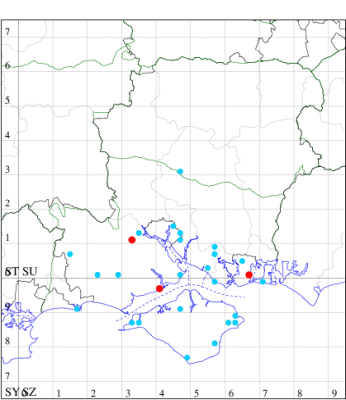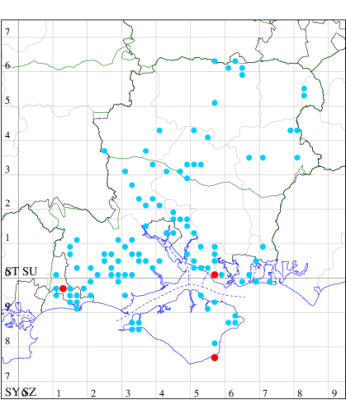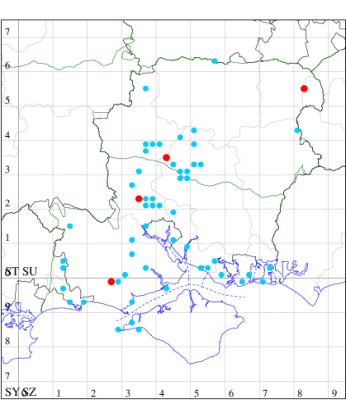2022 Annual Report for: Crambidae / Schoenobiinae
For species seen in 2022 that had less than or equal to 100 records, full details are included; for more common species, the earliest, latest and highest count by vice-county are shown. The narrative for each species is taken from the main Hantsmoths website, and it is possible that some information on abundance and occurrence can get out of date, as it is impossible to keep up with all changes; however it should give a good introduction to each species. The tables in each species account summarise the previous status, and that for the current year.
For the maps, all records prior to 2022 are shown by a blue dot (the larger the dot, the more recent), with the current year's records shown in red. As previous records are superimposed on any report for 2022, new sites have greater emphasis (i.e. will show as 'more red').
In the species accounts, an asterisk next to a location indicates a new 10km square record; earliest ever dates are highlighted in orange, and latest ever in red. Initials in the species accounts refer to the recorders listed here. Please get in touch if you identify any omissions or errors, in particular if you have records that have yet to be submitted. Details of how to submit records can be found here.
63.120 [B&F: 1328] Schoenobius gigantella ([Denis & Schiffermüller], 1775) - Local
Local in reed-beds in parts of southern England, with records north to Yorkshire, predominantly coastal. In Hampshire and on the Isle of Wight almost exclusively confined to the coast; remarkably, more than three-quarters of the records on the county database originate from a single garden in Southsea. Wingspan male 25-30 mm, female 41-46 mm. Male is unmistakable; female is considerably larger than that of Chilo phragmitella, in which the costa near the apex is convex, not concave, Donacaula forficella, in which the apex of forewing is even more pointed, with termen distinctly concave, and D. mucronellus, in which the forewing has broad, pale costal stripe sharply demarcated from a dark subcostal streak from base to apex [Goater]. Larva feeds within stems of Common Reed and Reed Sweet-grass, cutting part of a leaf to use as a raft to float to a new foodplant.
Records prior to 2022
| Vice County | #Records | #Individuals | First Record | Last Record |
|---|---|---|---|---|
| 10 | 13 | 15 | 1908 | 2021 |
| 11 | 122 | 134 | 1977 | 2021 |
2022 records
| Vice County | #Records | #Individuals | Max Quantity |
|---|---|---|---|
| 11 | 9 | 13 | 3 |

Records by year
Records by week (adult)
Records by week (larval)
Record Details
VC11: Franchises Wood, NF, present, 21 Jul (RBW); Portsmouth, one, 22 Jul (IRT); Needs Ore NNR, one, 10 Jul; one, 27 May; three, 07 Jun; one, 14 Jul; one, 17 Jul; two, 23 Jul; one, 13 Aug; three, 17 Jul; one, 29 Jul (CNB)
63.121 [B&F: 1329] Donacaula forficella (Thunberg, 1794) - Local
Local in marshes, river-banks and other damp areas throughout much of southern England, with records north to Yorkshire, and in Ireland. In Hampshire and on the Isle of Wight widespread and common throughout. Wingspan 25-30 mm. In D. mucronellus the costal stripe is sharply demarcated from dark subcostal streak and apical streak is wanting [Goater]. Larva feeds within stems of Common Reed, Reed Sweet-grass and Sedge, cutting part of a leaf to use as a raft to float to a new foodplant.
Records prior to 2022
| Vice County | #Records | #Individuals | First Record | Last Record |
|---|---|---|---|---|
| 10 | 21 | 16 | 1856 | 2021 |
| 11 | 268 | 335 | 1951 | 2021 |
| 12 | 28 | 8 | 1951 | 2013 |
2022 records
| Vice County | #Records | #Individuals | Max Quantity |
|---|---|---|---|
| 10 | 1 | 1 | 1 |
| 11 | 8 | 13 | 4 |

Records by year
Records by week (adult)
Records by week (larval)
Record Details
VC10: Bonchurch, one, 29 Jun (JHa);
VC11: Lee-on-Solent, one, 28 Jun (IHrg det. ASto); Hurn, one, 30 May; one, 16 Jun; one, 05 Jul; two, 06 Jul; one, 07 Jul; four, 13 Jul; two, 30 Jul (MJef)
63.122 [B&F: 1330] Donacaula mucronella ([Denis & Schiffermüller], 1775) - Nationally Scarce B
Nationally scarce (Nb) in marshes, river-banks and other damp areas throughout much of southern England, central Scotland and Ireland. In Hampshire local in fens and marshes, particularly in the Test valley. On the Isle of Wight, restricted to the extreme western corner. Wingspan male 22-26 mm, female 29-35 mm. The main confusion species is D. forficella, which see for differences. Larva feeds within stems of Common Reed, Reed Sweet-grass and Sedge.
Records prior to 2022
| Vice County | #Records | #Individuals | First Record | Last Record |
|---|---|---|---|---|
| 10 | 4 | 2 | 1966 | 2018 |
| 11 | 77 | 122 | 1951 | 2021 |
| 12 | 47 | 67 | 1951 | 2021 |
2022 records
| Vice County | #Records | #Individuals | Max Quantity |
|---|---|---|---|
| 11 | 3 | 3 | 1 |
| 12 | 2 | 2 | 1 |

Records by year
Records by week (adult)
Records by week (larval)
Record Details
VC11: Fishlake Meadows, one, 26 Jul (NRJ); Fishlake, one, with Nigel Jones / Fishlake Meadows, 26 Jul (SIng); Sway, one, 22 Jun (SKee);
VC12: Crawley, one, 26 May (GCE); Fleet Pond, one, 18 Jul (MHals)